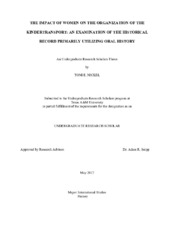| dc.creator | Nickel, Toni E | |
| dc.date.accessioned | 2017-10-10T20:32:26Z | |
| dc.date.available | 2017-10-10T20:32:26Z | |
| dc.date.created | 2017-05 | |
| dc.date.submitted | May 2017 | |
| dc.identifier.uri | https://hdl.handle.net/1969.1/164576 | |
| dc.description.abstract | As tensions rose in Germany before World War II, the danger faced by high-risk populations also rose. In response to this threat, organized evacuation efforts eventually became necessary for the survival of these targeted groups. The Kindertransports were efforts organized from various cultural, economic, and national divisions. The movement consisted of several organizations that formed loose coalitions with one purpose, to save children. These children, or ‘Kinder,’ were taken from Nazi Germany to Great Britain between 1938 and 1940. The Kindertransports saved roughly 10,000 Kinder from probable death. Coordination between Kinder, their families, the British government, the German government, and the governments of all countries Kinder passed through were necessary for the continued success of the movement. Through careful consideration of oral histories, public records, and relevant scholarly publications, this work proposes the extraordinary impact of women on the facilitation of this rescue and their impact on the memory of Kinder who later gave oral history. Each Kind who provided their history gave a unique story. However, consistencies became evident with a holistic view of the testimony. With the purpose of contextualizing these perceptions of women as caregivers and facilitators, this project follows the Kindertransports in an orderly manner from the times before the rise of Nazi Germany to the settlement of Kinder in Great Britain and the internment that many Kinder faced. This work focuses on both the actions of specific individuals and also generalizes about whole organizational groups. In the conclusion of this examination, it is clear that the Kinder’s perception of women as being instrumental in this rescue was indeed accurate. These findings are significant because most examinations of the Kindertransport depict women as secondary characters. This study continues the current historiography of looking at women as central characters in the historical narrative. | en |
| dc.format.mimetype | application/pdf | |
| dc.subject | Kindertransport, Refugee Children's Movement, Women, Women in the Kindertransport, Oral History, Memory of the Kindertansport, Operation Pied Piper, Internment, Rescue Organizations, Holocaust, Great Britain, Holland, Germany | en |
| dc.title | The Impact of Women on the Organization of the Kindertransport: An Examination of the Historical Record Primarily Utilizing Oral History | en |
| dc.type | Thesis | en |
| thesis.degree.department | International Studies | en |
| thesis.degree.discipline | History | en |
| thesis.degree.grantor | Undergraduate Research Scholars Program | en |
| thesis.degree.name | BA | en |
| thesis.degree.level | Undergraduate | en |
| dc.contributor.committeeMember | Seipp, Adam R | |
| dc.type.material | text | en |
| dc.date.updated | 2017-10-10T20:32:26Z | |


